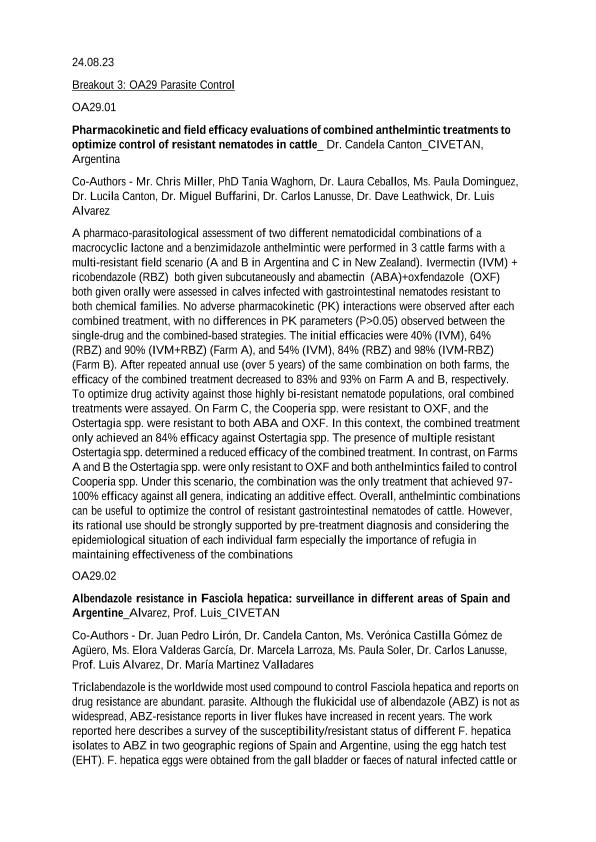Mostrar el registro sencillo del ítem
dc.contributor.author
Alvarez, Luis Ignacio

dc.contributor.author
Liron, Juan Pedro

dc.contributor.author
Cantón, Candela

dc.contributor.author
Castilla Gómez de Agüero, Verónica
dc.contributor.author
Valderas García, Elora
dc.contributor.author
Larroza, Marcela Patricia

dc.contributor.author
Soler, Paula

dc.contributor.author
Lanusse, Carlos Edmundo

dc.contributor.author
Martinez Valladares, María
dc.date.available
2023-11-28T17:44:56Z
dc.date.issued
2023
dc.identifier.citation
Albendazole resistance in Fasciola hepatica: surveillance in different areas of Spain and Argentine; 29th International Conference of the World Association for the Advancement of Veterinary Parasitology; Chennai; India; 2023; 1-2
dc.identifier.uri
http://hdl.handle.net/11336/218717
dc.description.abstract
Triclabendazole is the worldwide most used compound to control Fasciola hepatica and reports on drug resistance are abundant. Although the flukicidal use of albendazole (ABZ) is not as widespread, ABZ-resistance reports in liver flukes have increased in recent years. The work reported here describes a survey of the susceptibility/resistant status of different F. hepatica isolates to ABZ in two geographic regions of Spain and Argentine, using the egg hatch test (EHT). F. hepatica eggs were obtained from the gall bladder or faeces of natural infected cattle or sheep from different geographical areas of northern Spain (Castilla y León, Galicia and Asturias) and east (Litoral) and south (Patagonia) of Argentine. Fluke eggs were incubated at 25 ºC in darkness for a 12 h period with ABZ (0.5 nmol/mL). Untreated eggs served as control. After incubation, all eggs were gently washed to facilitate drug removal, and kept in darkness at 25 ºC for 15 days. After this period, eggs were exposed to light for 2 h to stimulate the hatching of miracidia. Hatched and unhatched (undeveloped) eggs were evaluated using an optical microscope and the ovicidal activity, expressed as a percentage, was calculated. A total of 42 (Spain) and 28 (Argentine) F. hepatica isolates were assessed for ABZ-resistance. After the EHT, 4 (9%) isolates from Spain results ABZ-resistant. The EHT could be successfully performed in 28 Argentinian isolates, resulting 75% of them resistant to ABZ. The high prevalence of ABZ-resistance in F. hepatica observed in Argentine can be explained by the widespread use of this flukicidal drug instead of triclabendazole. Oppositely, the low ABZ-resistance observed in the isolates collected from Spain may be related to the common use of a variety of alternative flukicidal drugs, such as closantel, nitroxynil and/or clorsulon.
dc.format
application/pdf
dc.language.iso
eng
dc.publisher
World Association for the Advancement of Veterinary Parasitology
dc.rights
info:eu-repo/semantics/openAccess
dc.rights.uri
https://creativecommons.org/licenses/by-nc-sa/2.5/ar/
dc.subject
FASCIOLA HEPATICA
dc.subject
RESISTANCE
dc.subject
ALBENDAZOLE
dc.subject.classification
Otras Ciencias Veterinarias

dc.subject.classification
Ciencias Veterinarias

dc.subject.classification
CIENCIAS AGRÍCOLAS

dc.title
Albendazole resistance in Fasciola hepatica: surveillance in different areas of Spain and Argentine
dc.type
info:eu-repo/semantics/publishedVersion
dc.type
info:eu-repo/semantics/conferenceObject
dc.type
info:ar-repo/semantics/documento de conferencia
dc.date.updated
2023-11-16T18:11:22Z
dc.journal.pagination
1-2
dc.journal.pais
India

dc.journal.ciudad
Chennai
dc.description.fil
Fil: Alvarez, Luis Ignacio. Consejo Nacional de Investigaciones Científicas y Técnicas. Centro Científico Tecnológico Conicet - Tandil. Centro de Investigación Veterinaria de Tandil. Universidad Nacional del Centro de la Provincia de Buenos Aires. Centro de Investigación Veterinaria de Tandil. Provincia de Buenos Aires. Gobernación. Comision de Investigaciones Científicas. Centro de Investigación Veterinaria de Tandil; Argentina
dc.description.fil
Fil: Liron, Juan Pedro. Consejo Nacional de Investigaciones Científicas y Técnicas. Centro Científico Tecnológico Conicet - Tandil. Centro de Investigación Veterinaria de Tandil. Universidad Nacional del Centro de la Provincia de Buenos Aires. Centro de Investigación Veterinaria de Tandil. Provincia de Buenos Aires. Gobernación. Comision de Investigaciones Científicas. Centro de Investigación Veterinaria de Tandil; Argentina
dc.description.fil
Fil: Cantón, Candela. Consejo Nacional de Investigaciones Científicas y Técnicas. Centro Científico Tecnológico Conicet - Tandil. Centro de Investigación Veterinaria de Tandil. Universidad Nacional del Centro de la Provincia de Buenos Aires. Centro de Investigación Veterinaria de Tandil. Provincia de Buenos Aires. Gobernación. Comision de Investigaciones Científicas. Centro de Investigación Veterinaria de Tandil; Argentina
dc.description.fil
Fil: Castilla Gómez de Agüero, Verónica. Universidad de León; España
dc.description.fil
Fil: Valderas García, Elora. Universidad de León; España
dc.description.fil
Fil: Larroza, Marcela Patricia. Instituto Nacional de Tecnología Agropecuaria. Centro Regional Patagonia Norte. Estación Experimental Agropecuaria San Carlos de Bariloche; Argentina
dc.description.fil
Fil: Soler, Paula. Instituto Nacional de Tecnología Agropecuaria. Centro Regional Patagonia Norte. Estación Experimental Agropecuaria San Carlos de Bariloche; Argentina
dc.description.fil
Fil: Lanusse, Carlos Edmundo. Consejo Nacional de Investigaciones Científicas y Técnicas. Centro Científico Tecnológico Conicet - Tandil. Centro de Investigación Veterinaria de Tandil. Universidad Nacional del Centro de la Provincia de Buenos Aires. Centro de Investigación Veterinaria de Tandil. Provincia de Buenos Aires. Gobernación. Comision de Investigaciones Científicas. Centro de Investigación Veterinaria de Tandil; Argentina
dc.description.fil
Fil: Martinez Valladares, María. Universidad de León; España
dc.relation.alternativeid
info:eu-repo/semantics/altIdentifier/url/https://waavp2023.com/final-abstracts/
dc.conicet.rol
Autor

dc.conicet.rol
Autor

dc.conicet.rol
Autor

dc.conicet.rol
Autor

dc.coverage
Internacional
dc.type.subtype
Conferencia
dc.description.nombreEvento
29th International Conference of the World Association for the Advancement of Veterinary Parasitology
dc.date.evento
2023-08-20
dc.description.ciudadEvento
Chennai
dc.description.paisEvento
India

dc.type.publicacion
Book
dc.description.institucionOrganizadora
World Association for the Advancement of Veterinary Parasitology
dc.source.libro
Abstracts of the 29th International Conference of the World Association for the Advancement of Veterinary Parasitology
dc.date.eventoHasta
2023-08-24
dc.type
Conferencia
Archivos asociados
